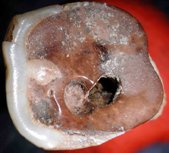Prehistoric trips to the dentist
Thousands of years ago, some people had holes drilled into their teeth.
By Emily Sohn
Going to the dentist has a much longer history than you might imagine.
Researchers recently unearthed what may be the earliest examples of ancient dentistry yet discovered — holes drilled in teeth that are between 9,000 and 7,500 years old.
The teeth come from a prehistoric farming village called Mehrgarh in what is now Pakistan. A total of 11 teeth from nine adults contained drilled holes, the researchers report.
 |
|
Discovered in an ancient farming village, this tooth has a hole that was drilled into its chewing surface.
|
| L. Bondioli and R. Macchiarelli |
Cavities caused by tooth decay can be painful. If untreated, decaying teeth will eventually rot away or fall out.
Dentists today use power drills with metal tips to scour out cavities and prevent decay from spreading. Mehrgarh dentists probably used tools made from flint.
These ancient people already used sharpened flint attached to wooden rods to drill holes for making beads out of pieces of shell, turquoise, and other materials. It wouldn’t have been hard for them to use the same skills to drill teeth.
Drilled holes in the Mehrgarh teeth are between 1.3 and 3.2 millimeters wide and between 0.5 and 3.5 millimeters deep. The edges are smooth, which suggests that patients were alive when the holes were drilled and remained alive for a long time afterwards, because chewing continued to wear down their teeth. Researchers aren’t yet sure whether some type of filling once plugged the holes.
The holes were probably not made for decoration or display because the teeth in question sat far back in people’s mouths.
Four of the teeth had decay next to the holes. Scans with high-powered imaging equipment showed ridges within the holes that might have been made by a flint drill. Both observations support that the idea that the people of Mehrgarh were actually practicing dentistry and digging out cavities.
To check their conclusions, the scientists made models of prehistoric stone tools and used them to drill human cheek teeth. (The teeth were not attached to people at the time.) Using this method, it only took a minute to make a hole that resembled the ones that Mehrgarh dentists made.
Getting cavities drilled and filled is important, but it can be uncomfortable. Next time you’re at the dentist, however, just be thankful that there’s no sharp blade of flint in your mouth. That could be really unpleasant!
Going Deeper:
Bower, Bruce. 2006. Mystery drilling: Ancient teeth endured dental procedures. Science News 169(April 8):213. Available at http://www.sciencenews.org/articles/20060408/fob5.asp.







